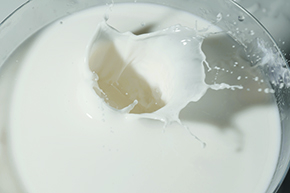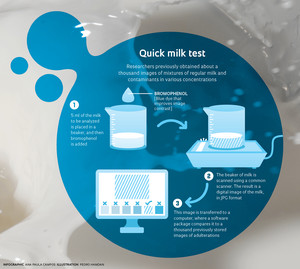 Eduardo Cesar
Eduardo CesarThe use of digital images for the analysis of food has already been described in the scientific literature. It can be used to verify the quality of ham, to count lactobacilli in fermented milk and also to determine the size of rice grains. Inspired by these examples, the group at UFSCar obtained milk samples donated by a dairy company in the São Carlos region and tampered with them using the top five substances commonly used by tamperers, in concentrations of 5% to 50%. One of them, tap water, is used to increase volume, and thus to increase profits. Buttermilk, however, which is a byproduct from the manufacture of cheese, is added to milk to mask the addition of water and maintain the concentration of protein within the range defined by Brazilian legislation (2.9%).
The synthetic urine used in the experiment—a mixture of salts, water and other substances commonly found in urine, such as urea and creatinine—has the same purpose. The main objective is to mask the addition of water. The fourth fraudulent substance is synthetic milk, a contaminant consisting of a mixture of water, detergent, oil, and urea, used for the same reason as buttermilk. The final product used in adulteration, hydrogen peroxide, inhibits bacterial growth and thus prolongs shelf life.
After being tampered with, the samples were placed in glass beakers and drops of bromophenol, a blue die, were added to improve the color contrast between normal and adulterated samples of milk because the bluish tone varies depending on the concentration of the contaminant. “The beakers were placed on the glass of a printer scanner to generate digital images,” explains Pereira. Each of the mixtures resulted in an image in the jpg (Joint Photographic Experts Group) format. In this way, about a thousand images were obtained, each corresponding to a different type of adulteration.
 Infographic: Ana pAula Cmapos
Infographic: Ana pAula Cmapos
The images were stored on a computer. When you want to test a sample, you need to scan a beaker containing a little bit of milk in order to generate an image. Using special software, it is compared with the thousand previously stored images. One can identify if the new sample is the same as one of the test samples, thus detecting fraud. If the contaminant does not match a stored image, the program cannot identify it, but it can determine that the milk is not pure.
According to data from the Brazilian Institute of Geography and Statistics (IBGE), 32.3 billion liters of milk were produced in Brazil in 2012. There is no precise data on fraud. “The percentage is around 10%,” says Pereira. “We only have information on cases reported in the media.” Globally, however, there is more data. In her dissertation, Santos cites a study conducted at the University of Michigan that showed that milk is one of the seven foods most susceptible to tampering, along with olive oil, honey, saffron, coffee, and apple and orange juices.
In Brazil, the quality of the product is monitored by local, state and federal agencies. Companies registered with the Federal Inspection Service (SIF) are authorized to engage in interstate or international trade and are monitored by the Ministry of Agriculture and Supply through periodic inspections or audits. These inspections cover manufacturing processes, compliance with good manufacturing practices and standard operating procedures. In addition, the ministry’s program Fighting Milk Fraud includes, among other things, analyses to detect hydrogen peroxide, starch, chlorides, acid neutralizers, sucrose, ethanol and buttermilk.
In her thesis, Santos says that the analyses of milk quality in Brazil are based on the calculation of some physical and chemical properties, such as acidity, fat, and dry extract, but these methods are often unable to directly detect if tampering occurred. In addition, the tests are time consuming, consume many chemical reagents and require specific, expensive equipment. This is why, according to the UFSCar researchers, the method they developed is better than other techniques because it is quicker, and tests can be done in real time. “Furthermore, the procedure we created is more likely to be portable and used in the field. Suspect samples could be sent to specialized laboratories for further testing,” says Pereira. To become marketable, the method still needs a company interested in developing it as a product.
Project
Application of digital image and spectroanalytical techniques combined with chemometrics analysis to detect and quantify adulteration in bovine milk (nº 2009/01345-6); Grant Mechanism PhD Scholarship, Scholarship Recipient Poliana Macedo dos Santos; Coord. Edenir Rodrigues Pereira Filho; Investment R$111,668.91 (FAPESP).
Scientific articles
SANTOS, P.M. et al. Digital image analysis – an alternative tool for monitoring milk authenticity. Analytical Methods. v. 5, p. 3,669-74. Aug. 2013.
SANTOS, P. M. et al. Scanner digital images combined with color parameters: a case study to detect adulterations in liquid cow’s milk. Food Analytical Methods. v. 5, p. 89-95. 2012.